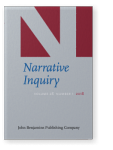After asylum
Hermeneutic composability in former refugee narratives
In this study I examine a corpus of former refugee narratives published by the nonprofit Refugee Council of Australia (RCOA) on their website in 2011. In order to investigate the relationship between the constituent parts and the narrative as a whole, I use critical discourse analysis to examine the strategic use of person, quantified temporal phrases, broader thematic elements, and the constitution of “former refugee narrative” as a genre. I conclude that the RCOA dominates temporality and maintains authority over the narratives through specifically applied quantification yet captures the necessary subjective and emotional material of the refugee experience to achieve the authenticity the co-narratives need to be well-received by the public. Thus, by manipulating hermeneutic composability, the RCOA evidences an objective, authoritative portrayal yet captures a subjective experience worth telling, and by manipulating intertextual gaps they appeal to the Australian nationalism implicit in the contemporary political climate.
Article outline
- Introduction
- Entextualization of refugee narratives and the intertextual gap
- Hermeneutic composability and narrative structure
- Chronological events
- Thematic elements
- Discussion and conclusion
- Acknowledgements
-
References
References (33)
Australian Government, Department of Immigration and Border Protection
(
2017a,
April 18).
Abolition and replacement of the 457 visa – Government reforms to employer sponsored skilled migration visas. Canberra, Australia. Retrieved from
[URL]
Australian Government, Department of Immigration and Border Protection
(
2017b,
April 18).
Temporary Work (Skilled) visa (subclass 457). Canberra, Australia. Retrieved from
[URL]
Baker, P., Gabrielatos, C., KhosraviNik, M., Krzyz̊anowski, M., McEnery, T. & Wodak, R.
(
2008)
A useful methodological synergy? Combining critical discourse analysis and corpus linguistics to examine discourses of refugees and asylum seekers in the UK press.
Discourse & Society, 19(3), 273–306.


Bauman, R., & Briggs, C. L.
(
1990)
Poetics and performance as critical perspectives on language and social life.
Annual Review of Anthropology, 191, 59–88.


Bauman, R.
(
1996)
Any man who keeps more’n one hound’ll lie to you: A contextual study of expressive lying. In
D. Brenneis &
R. Macaulay (Eds.),
The matrix of language (pp. 160–181). Boulder, CO: Westview Press.

Blommaert, J.
(
2001)
Investigating narrative inequality: African asylum seekers’ stories in Belgium.
Discourse & Society, 12(4), 413–449.


Blommaert, J.
(
2009)
Language, asylum, and the National Order.
Current Anthropology, 50(4), 415–441.


Briggs, C. L., & Bauman, R.
(
1992)
Genre, Intertextuality, and Social Power.
Journal of Linguistic Anthropology, 2(2), 131–172.


Bruner, J.
(
1991)
The narrative construction of reality.
Critical Inquiry, 18(1), 1–24.


Bucholtz, M., & Hall, K.
(
2004)
Language and identity. In
A. Duranti (Ed.),
A companion to linguistic anthropology (pp. 369–394). Malden, MA: Blackwell.

Corcoran, C.
(
2004)
A critical examination of the use of language analysis interviews in asylum proceedings: A case study of a West African seeking asylum in the Netherlands.
Speech, Language and the Law, 11(2), 200–221.


Ewick, P., & Silbey, Susan S.
(
1995)
Subversive stories and hegemonic tales: Toward a sociology of narrative.
Law & Society Review, 29(2), 197–226.


Gabrielatos, C., & Baker, P.
(
2008)
Fleeing, sneaking, flooding: A corpus analysis of discursive constructions of refugees and asylum seekers in the UK Press, 1996–2005.
Journal of English Linguistics, 36(1), 5–38.


Gee, J. P.
(
2005)
An introduction to discourse analysis: Theory and method. New York: Routledge.

Harvey, P. & Knox, H.
(
2015)
Roads: An anthropology of infrastructure and expertise. Ithaca, NY: Cornell University Press.


Hodges, A.
(
2011)
The “war on terror” narrative. Oxford: Oxford University Press, Inc.


Jacquemet, M.
(
2009)
Transcribing refugees: The entextualization of asylum seekers’ hearings in a transidiomatic environment.
Text & Talk, 29(5), 525–546.


Jacquemet, M.
(
2011)
Crosstalk 2.0: Asylum and communicative breakdowns.
Text & Talk, 31(4), 475–497.


KhosraviNik, M.
(
2009)
The representation of refugees, asylum seekers and immigrants in British newspapers during the Balkan conflict (1999) and the British general election (2005).
Discourse & Society, 20(4), 477–498.


Labov, W.
(
1972)
Sociolinguistic patterns. Philadelphia: University of Pennsylvania Press.

Malkki, L.
(
1992)
National Geographic: The rooting of peoples and the territorialization of national identity among scholars and refugees.
Cultural Anthropology, 7(1), 22–44.


Massola, J.
(
2017a,
April 18).
Malcolm Turnbull to abolish 457 immigration work visas.
The Sydney Morning Herald. Retrieved from
[URL]
Massola, J.
(
2017b,
April 20).
Malcolm Turnbull reveals tough new citizenship crackdown.
The Sydney Morning Herald. Retrieved from
[URL]
Refugee Council of Australia
(
2013,
May).
Who we are. Retrieved from
[URL].
Refugee Council of Australia
(
2014a,
March).
Refugee stories. Retrieved from
[URL]
Refugee Council of Australia
(
2014b,
December).
What we do. Retrieved from
[URL].
Smith-Khan, L.
(
2017)
Telling stories: Credibility and the representation of social actors in Australian asylum appeals.
Discourse & Society, 28(5), 512–534.


Taylor, C.
(
1979)
Interpretation and the Sciences of Man. In
P. Rabinow and
W. M. Sullivan (Eds.),
Interpretive social science: A reader (pp. 25–71). Berkeley: University of California Press.

Vogl, A.
(
2013)
Telling stories from start to finish: Exploring the demand for narrative in refugee testimony.
Griffith Law Review, 22(1), 63–86.


White, G.
(
2004)
Nation, state, and territory: Origins, evolutions, and relationships, Volume 1. Lanham, MD: Rowman & Littlefield Publishers, Inc.

Zagor, M.
(
2014)
Recognition and narrative identities: Is refugee law redeemable? In
F. Jenkins,
M. Nolan and
K. Rubenstein (Eds.),
Allegiance and identity in a globalised world (pp. 311–353). Cambridge, UK: Cambridge University Press.


Cited by (1)
Cited by 1 other publications
Clark, Sal, Ashleigh Haw & Laurel Mackenzie
2024.
The “good refugee” ideal: How discourses of deservingness permeate Australia's refugee and asylum seeker narratives.
Australian Journal of Social Issues 59:1
► pp. 148 ff.

This list is based on CrossRef data as of 10 july 2024. Please note that it may not be complete. Sources presented here have been supplied by the respective publishers.
Any errors therein should be reported to them.
